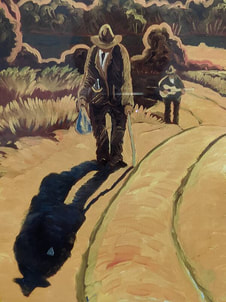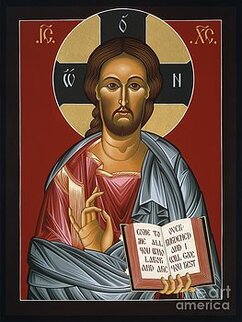 I am quite fond of a painting which depicts a man walking on a desert road in New Mexico. The man is described by the artist as an abuelo, a grandfather, a character which appears in many of his works. The abuelo always has a partially empty bottle of liquor in one coat pocket, is a little bit bent over, and walks with a cane. His face is rarely seen since he is usually walking away from the viewer. In this particular painting, however, he is walking toward the viewer with the sun at his back and thus, his shadow is in front of him. In this is revealed my favorite part of the painting; only visible in the shadow, is his heart. We have heard the expression about ‘wearing our heart on our sleeve’ which refers to someone who expresses emotions freely without attempting to hide them. Sometimes this saying is used to infer that emotion ‘for all to see’ is a fault, as if the person cannot hide anything, but ought to. It can also mean “to be ‘guileless,’ meaning there is no insincerity or pretense to them.”* In the painting, the visible heart reveals that this man is someone with almost no pretense; he seems to hide little. While his heart is not depicted on his sleeve, which is really only an idiom anyhow, he is willing to share it, to make it vulnerable, and even to risk that it be trod upon. This is what the gospels call us to do: to allow our hearts to be made visible, just as Jesus did.  In reading the gospels it is clear that Jesus was transparent. He never hid His intentions while teaching publicly in order that He might attract followers who could then receive the gift He offered. It was for this that Jesus came. He healed people, worked miracles of all sorts, preached, and even suffered and died in full view of the public. He was true to His own teaching: He said, “No one who lights a lamp conceals it with a vessel or sets it under a bed; rather, he places it on a lampstand so that those who enter may see the light.” (Luke 8:16) In other words, we are to make no secret of our Christianity by living as if we are ‘double agents’ with a spiritual life somehow separated from our public life. We do not live two lives, but one. While Jesus did say to pray and do good works in secret, He meant that we were not to seek reward or acclaim, but rather to do good things in His’ name with humility. As to how we live our daily lives, it ought to be clear to others that we are Christian.  There is a hymn called “They Will Know We Are Christians by Our Love.” The lyrics describe how others will know who we are because of the love with which we live. This is exactly what the gospel message of Jesus is about: we are to live as transparently as He did. Those who we consider holy, the saints, all lived this way. They were about love which was offered as forgiveness, mercy, works of service, humility, prayerfulness, and that which they taught in words when necessary. Jesus taught His disciples to do these things even after His resurrection: they were to spread the gospel to the ends of the earth. They were to do as Peter and John did in the Temple area when they gave a lame beggar what they had. Peter said to him, “I have neither silver nor gold, but what I do have, I give to you: in the name of Jesus Christ the Nazorean, arise and walk.” The man leapt up, praising God. (Acts 3: 1-10) Those who would be known as Christians were to feed the hungry, clothe the naked, visit the ill and imprisoned, give shelter to those without it, give a cup of water to a poor one, set the captive free, (the lonely, wounded, abandoned, despairing alien and outcast). They shared what they had through almsgiving and even ate their meals “with exultation and sincerity of heart.” (Acts 3:46) These folks wore their hearts on their sleeves; undeniably their hearts belonged to Jesus Christ.  As Christians, we, too, are called to wear our hearts on our sleeves, not in sentimentality and ‘over-the-top’ effusion of emotion, but rather we are called to share our love openly and generously. There is never a reason to hide our hearts in the shadows or only let them meekly peek out. We are called to wear our hearts and our mercy on our sleeves; we are called to wear our faith, hope, and love on our sleeves. Indeed, we are called to wear the gospel on our sleeves. Our faith, recently expressed in the renewal of our baptismal promises at Easter, is about living the Christian life openly and unabashedly. We can do more than we realize if we wear the gospels, and therefore our love, ‘on our sleeve’ in our daily lives. We have been empowered to do so through the Sacraments and we can continue to grow in the power of love through prayer and frequent reception of Reconciliation and the Eucharist. During the Easter season we celebrate that Jesus arose through the power of love, the love He ‘wore’ openly by revealing His heart to everyone. As His followers we must choose to do this, too; that is, to wear His heart, entwined with our own, on our sleeves.  May we wear our heart, entwined with that of Jesus, on our sleeves that others may receive of His love! May we have the courage to follow Jesus as disciples, leading others to the Kingdom through our words and actions! And may we be inspired to live humbly and with mercy by frequently reading the gospels! Let us continue to meet in the Heart of Jesus! Alleluia! Peace! ©Michele L. Catanese *As defined in the Google Dictionary, "also guileless: devoid of guile; innocent and without deception." Images: 1. My photo, inset of an oil painting, The Long Walk Home by Ed Sandoval. I have a signed poster of this painting, so I took a photo of it and then cropped it so the heart of the abuelo could be more visible. 2. My photo, a chunk of glacial ice held by my husband, Tony. I chose this photo because this is the clearest, most transparent chunk of ice I have ever seen. It literally was taken from a small iceberg in a glacial lake near Mt. Cook, New Zealand 3. Painting, St. Peter Healing the Cripple, by Mancini, 1748. This is found at the altar of St. Peter in St. Peter's Basilica, Vatican City. http://stpetersbasilica.info/Altars/StPeter-Cripple/StPeter-Cripple.htm 4. My photo, on the Dart River, Glenorchy, New Zealand. The water was incredibly clear on this river. 5. Icon, Christ All Merciful, by Fr. William Hart McNichols. You can find this at https://fineartamerica.com/featured/christ-all-merciful-022-william-hart-mcnichols.html NOTE: In compliance with GDPR rules, I wish to make it clear that I do not gather any information on any of my readers at any time.
Marian Harper
4/18/2021 02:24:41 pm
Reminded me of a song I love by Gallagher and Lyle 1976 “Heart on my sleeve”! Comments are closed.
|
Heart Speaks to Heart
|

 RSS Feed
RSS Feed

